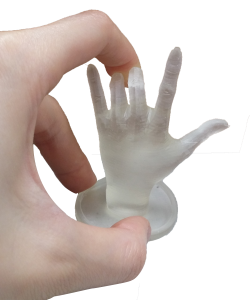Applicable printer: Nobel 1.0A
Due to the flexible resins being softer compared to general purpose acrylic resins, the material’s characteristics enrich of the application of stereo-lithography printing technology. When printing thin structures, the product can be easily bent, while thick structures are flexible, compressible and vibration resistant.
Model Design Tips
The resin is softer and flexible, which causes it to be prone to deformation and breaking due to the peeling force during printing. The thinner and higher structure, the easier it is affected. Please follow the design tips below for optimized printing.
» Vertical-Wire Diameter ≧ 0.6mm
» Overall height ≦ 100mm
» Horizontal overhang structure length < 10mm (adding support structures may improve the stability of the structure)
» For the specs for other features, please follow the general design specs here.
Recommendations on Printing Setup
Use the “Rotate” function to turn directions, situating the solid structure’s center of gravity on the base of the platform.
Choose “Mid” or “High” for support density and “Mid” or “Large” for the size of the contact point of the support, since the support structures of low density and small contact are prone to deformation and breaking while being printed.
Recommendation on Finishing
Removing the prints from the platform
Printouts of flexible resins are fragile. Carefully retrieve the printout by scraping it off gently.
Note » The thin brim is prone to breaking when being scraped off from the platform. » Make sure to remove all residual structures on the platform to avoid affecting the next printing.
Cleaning
Same as cleaning general purpose resin printed items, immerse the item in 95% concentration alcohol and gently brush the surface of the item for 10 minutes with a soft brush (alternatively, use a ultrasonic cleaner), and remove the printed item after rinsing and allow the alcohol on the surface to evaporate completely.
Note » Do not immerse the printed item in alcohol for over 10 minutes to avoid the alcohol from eroding the item's surface structure and damaging the item. Tip » Prior to cleaning, use a soft cloth to wipe off the uncured resin on the surface to allow for easier cleaning.
Post-Curing
To reduce the stickiness on the surface of the flexible resin printed item, post-cure the item with UV curing equipment after completely cleaning the surface of the item with alcohol.
Click here to read the curing profile for using XYZprinting UV Curing Chamber (Model: 3UD10).
Note » The flexible resin will harden after exposure to UV light; make sure to avoid over curing to UV light.
Preservation of the Uncured Resin
Uncured resin inside of the resin tank should not be exposed to light. The uncured resin can be stored in an opaque container after it is filtered. Pour the resin back into the resin tank prior to the next printing.
Note » Opaque polypropylene containers are recommended for storing the resins.

